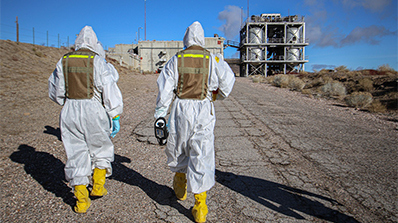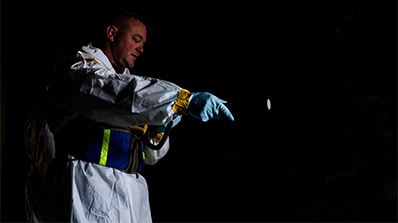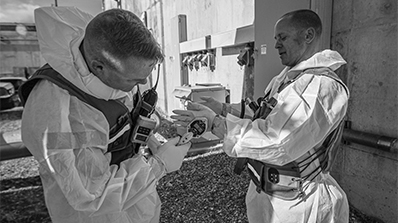Approaching 250,000 individuals trained, the Nevada National Security Site’s Counterterrorism Operations Support (CTOS) team serves as the nation’s premier training organization for radiological/nuclear prevention and response training.
CTOS is one of seven members in the National Domestic Preparedness Consortium, operated under the National Preparedness Directorate of the U.S. Department of Homeland Security’s Federal Emergency Management Agency. Comprised of web-based classes, mobile deliveries at host locations and on-site NNSS courses, CTOS offers an unprecedented training experience for organizations and agencies nationwide. The program is administered by a skilled training staff, including individuals with first responder, emergency response and military backgrounds.
The Site hosted members of the National Guard Civil Support Team in December at its Phoenix and T-1 locations for exercises that demonstrated how responders establish zones, characterize hazards and operate in a unified incident command structure with other agencies.
“The biggest advantage CTOS has is its size, its strength and its resources,” said CTOS instructor Paul Lunny. “Each group brings its unique perspective of the job. The key is getting all these people who do this work on the same page.”

Past meets present
The Phoenix site is an industrial complex utilized in the early 1960s for Project Pluto, a program that explored development of nuclear-powered ramjet engines. After its closure, the facility began to be used for hands-on training in the early 1970s. Today, it can be safely adapted for different scenarios and disciplines through placement of sealed sources.
T-1 also features a historical connection conducive to present-day training. Low levels of radiation remain in the soil of the 10-acre training area from 1950s testing in addition to radioactive debris from the detonations, which gives participants a realistic perspective of working in a contaminated area.
“It’s all good training because we don’t get a lot of radiation training with large sources like you all have,” said Jeremy Murry with the 46th Civil Support Team, Alabama National Guard, who has completed three training courses at the NNSS. “It’s always good, especially for the new people on the team. Being around the history of it – we were out at the T-1 site where they actually did a blast there and we were actually picking up the radiation there at the site.”
Though training has been offered since 1999, the T-1 area was reconfigured following Sept. 11, 2001, to include city infrastructure. A locomotive, community buildings, vehicles and a Boeing 737 are some of the assets used to simulate real-world situations. Both T-1 and Phoenix maximize trainees’ usage of instruments and response procedures in weapons of mass destruction, radiological dispersal device and improvised nuclear device scenarios.
“The instructors were super knowledgeable, very professional and would explain anything in as much depth as you want them to,” said Amanda Plumer with the 52nd Civil Support Team, Ohio National Guard. “The Site has so many props and so many things you can do with scenarios. It was great. When you think radiation, you’re like, ‘I can’t be around that. I can’t be around there too long.’ They break it down, they give you examples and give you scenarios where you’re actually working around it and you check your dose and you can see it’s not as dangerous as it can be perceived as.”

Nationwide mission
CTOS’ outreach works to train state, local, territorial and tribal representatives to break down myths surrounding radiation and maximize the number of individuals capable of responding in a real-world situation. These groups include: law enforcement, emergency medical services, healthcare professionals, public safety communications, hazardous material units, search and rescue, and security and safety personnel. With varied clients, the focus remains on how each group supports an integrated emergency response.
“Anybody can be called to do this,” said CTOS instructor John Craft. “Regardless of your duty position, anyone can be engaged and probably will be.”
Scenarios during National Guard Civil Support Team training included working to identify activities in a clandestine laboratory, a traffic incident with a compromised source outside of a vehicle, conducting interior and exterior facility searches, and identifying sources in coordination with a fire chief incident commander. Teams practiced making detections through instrument readings, characterizing the field of energy, locating sources, identifying isotopes, personal protective equipment and decontamination, and communicating findings through the incident command structure throughout the entire process.

“There’s a lot of good training value that comes out of going somewhere that you’ve never been before, getting training, getting out of your element and to put focus on what you’re learning as opposed to your day-to-day operation,” said Riley Turner with the 52nd Civil Support Team, Ohio National Guard. “The radiological sources and instructors were great, very knowledgeable and very seasoned. Normally, we train with more button sources – smaller sources – that aren’t giving off as much radiological energy. Having actual sources and predetermined scenarios where the sources shine through in a certain way directionally was really good.”
Whether conducted remotely or onsite, CTOS continues to offer an unparalleled training environment in support of national security.
“We love getting out and meeting new agencies and building relationships with those agencies,” Turner said. “The NNSS is very good for an area and a common operating picture to grow.”
For more information about CTOS training and availability, offered at no cost to participating organizations, see http://www.ctosnnsa.org/index.htm.

